Earl Twigley, manager for Humphrey Bayly on Okare Station, Wairoa, at Wairere, November 2021. Okare has been buying Wairere rams since 1987, except for a brief interval with Perendales twenty years ago. Earl is a quiet achiever, consistently lambing in the high 130s to 140% from 17,000-18,000 ewes, plus 2,500 to 3,000 lambs from the 6,000
hoggets Earl: “Okare is later country, and I’ve been finishing a lot of the 21,000 sale lambs through to March. But there is a limited area available for a summer feed crop, and weeds have become a problem. With the move back to permanent pasture I’ve decided to wean in December rather than January and feed ewes better in summer for a
higher lambing percentage and sell most lambs store at weaning.”
(Sheep farmer accounts show no correlation between profitability and selling store or prime, according to a recent Ballance seminar).
International food prices are at their highest in decades. That’s good for New Zealand farmers, as is a depreciating exchange rate. That will protect farm gate income as the New Zealand trade deficit continues to widen. Equity is also very strong for sheep and beef farmers, albeit bolstered by carbon subsidies. Another factor underpinning the price of property is the fast shrinking supply of farm land. Contrast this to the late 1980s, when many farmers found themselves in a negative equity position and forced to sell up. Product prices were abysmally low.
Let’s make the most of our current good fortune
The big picture
The rich countries make the rules. The EU has now made nuclear energy and natural gas “sustainable”. Will those countries currently exporting fossil fuels change to saving it for their own use? Should New Zealand plan to be more dependent or more self reliant? For example, New Zealand has eight billion tonnes of accessible coal. Should we be exporting more coal, instead of accepting a $23 billion trade deficit? It works for Australia, which didn’t sign the Paris Accord, has the highest per capita GHG figure in the world, yet has farm gate prices higher than here. New Zealand will lose a lot of talented young people to Australia because it offers a higher standard of living.
New Zealand’s productivity record is woeful, and it just keeps getting worse. Instead of doing more with less, New Zealand is doing less with more…more bureaucrats, more beneficiaries, more consultants, more cogovernance, more rent seekers. The burden keeps increasing on the productive sector. The government’s ideological stance has a high cost.
Ruminants and climate change
Making New Zealand poorer, faster, than other countries is self defeating. The beat up around GHGs, water quality and biodiversity treats farmers as scapegoats.
GHGs? New Zealand politicians plan to be the first country, perhaps the only one, to tax ruminants for GHG emissions. Ruminants evolved 90 million years ago, and are suddenly responsible for climate change? It’s a convenient political move. Farmers are an easy target for lobby groups, academics, politicians. The reality is that we will have to adapt to any change in climate. Farmers are good at adapting.
Water quality? As with OSH, there was/is room for improvement. Many farmers have already invested in fencing off streams, variable fertiliser placement, QE2 covenants, changed crop feeding systems, etc.
Biodiversity? The QE2 covenants voluntarily donated by farmers would be our fifth largest National Park.
Wairere Central Districts Red Meat Farmer of the Year
Wairere is the key sponsor for this revitalised competition. The Central Districts is one of the best farming areas in New Zealand, large and diverse. Showcasing excellence can provide inspiration. Inaugural winners are Ian and Steph Strachan, who run a finely tuned finishing business at Kiwitea, achieving around 700kgCW per hectare. Finishers have made a big contribution to lifting average New Zealand lamb carcase weight over the last twenty five years. There will be a field day in October, where lessons learned by the Strahans since being an MRDC monitor farm in the 1990s will be on display.
Runners up in this year’s comp were Derek and Leanne White, who run a 435ha property northwest of Taihape. “Altitude ranges from 560-800m. In 2021 the 3,000 ewes lambed 155% with the 900 scanned in lamb hoggets at 92%, giving us a total of 12 lambs per hectare survival to sale.
Breeding cows, with all yearlings retained, help complement the 5,000su wintered. New grasses plus winter and summer forage crops play an integral role for wintering and helping achieve the finishing of 90% of lambs sold.
Eight years ago I changed from a North Island Romney to a Texel composite, chosen because of high EBVs on Flockfinder. That turned out to be a mistake. Though the first cross had excellent growth rate, the two tooth scanning dropped by 30%. At that point, three years ago, I started buying Wairere Romney rams to get back to a flock which can absorb the increasingly frequent dry summer/autumns and bounce back to consistent high productivity.”
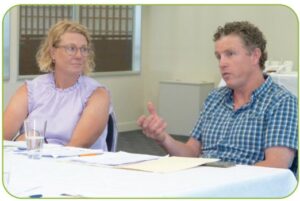
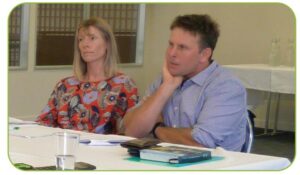
Top: Ian and Steph Strahan
Bottom: Derek and Leanne White
History repeats
Twenty years ago a Wairere newsletter featured “Ten big issues facing sheep farmers”., and what Wairere was doing about them. The issues are the same today, though progress has been made.
1. Supply/demand. The main destination for our sheep meat has changed from Europe to China. The Chinese market has added $40-50 per lamb, with stronger demand and prices for what used to be the low or no value items. Red meat is gaining popularity over poultry and pork, and the escalating cost of grain has brought the retail price of white meat closer to that of red meat.
In 1990 Wairere became a shareholder in Lean Meats. That company has come of age, with consistent supply premiums and shareholder dividends over the past seven years. The other processor/marketers have also become smarter and more sophisticated.
2. Competition for land use. Our biggest problem is the politically contrived market for carbon. This has pushed hill country land values up to $15-25,000 per hectare. How can farmers compete against a subsidy?
What about profitability? Kg product per hectare times dollars per kg, less costs per hectare. The steady improvement in national lambing percentage and average lamb weight is a credit to you all on the land. Specialist finishers have made the most of high octane pasture mixes to accelerate growth rate and eating quality. Breeding farmers have increasingly adopted body condition scoring, superior genetics, hybrid vigour and other tools to optimise input and output. Our biggest limitation is permanent pasture for annual quantity and quality of feed, which in turn limits the kgs of meat produced.
Two tips from past newsletters: From 2013: Richard Strowger, an ex dairy farmer in the dry area of North Otago, used nitrogen in spring and/or autumn if feed shortages threatened. He also used palm kernel and barley in the spring to relieve pastures from being grazed too short. Richard was achieving lambings up to 175%, buying in ewe lamb replacements every year. He noted that growing a hogget to 55kg by May didn’t cost much more than growing one to 40kg, but the performance profile was so much better as a hogget, and subsequently. A recent catch-up with Richard confirmed this approach. He has calculated that a client in his consultancy, who buys 35kg ewe lambs in January, grows them to 55kg for mating as hoggets, and sells them as two tooths, generates 62 cents/kgDM.
Pasja works particularly well for achieving the growth target and, undersown with ryegrass/clover, provides good winter feed. Nine years later, Richard is not a fan of palm kernel, because so much more of the oil is extracted than used to be, leaving kernel with a low ME around 9.
John and son Will Lindsay, Dipton, Southland. “We buy Wairere Romney ewe lambs from John Chittock at The Jeff Farm, then mate them to Poll Dorset/Texel rams, keeping the females from that cross…which are then mated to terminal sires(normally SuffTex). Of the 8,500 ewe flock, the terminal half are mated early, starting lambing August 20. The Romney and PD/Tex/Rom maternal ewes start lambing a month later. “Lambing percentage is consistently in the 160s, with half the sale lambs sold by January 10. We work on a 37kg cut off for POM, doing a couple of early skim drafts before weaning. Nutrition at the right time of year is key. We feed fodder beef to sheep, which allows pasture to be spelled before set stocking for lambing. Hoggets are normally mated, but not this year.
The hill country which we developed with spray and pray is now surrounded by the neighbours’ pine trees. Wilding pines are sprouting like hairs on a cat’s back.
Our sheep system is slightly complicated, but maximises hybrid vigour. The sooner in the season that sale lambs leave the farm helps create a virtuous cycle, allowing better feeding of ewe lamb replacements and ewes”.
3. Cost of production. Labour shortages are more acute than twenty years ago. Progressive farmers are close to maxing out the use of laneways, yards out on the farm, clamps, conveyor belts, and the use of contractors.
Since 1929 Wairere has selected for sheep with strong constitution, structural soundness, and minimal dags. Nudies will be another step towards low input sheep. Bare Romneys and our composite Multipliers and Tufguys are also designed towards the perfect easycare sheep.
4. Fertility/fecundity. Starting with fertility, Wairere has mated all ewe hoggets every year since 1966. In 2005 it was decided to retain only those hoggets which were pregnant…early maturity, early profit. Fecundity: feedback indicates that Wairere genetics have reached a sweet spot with scanning percentage. Every extra percent scanned over 185 is a percent of triplets. Survival and growth rate of triplets have become the keys to the economic optimum on your farm.
Every year we look in depth at the weaning record of every recorded ewe. The ewe summary shows number of lambs reared(not just born), weaning weights, whether the progeny were sold as rams(and who to), or retained as replacement ewes.
5. Lamb survival. Higher lamb survival starts with high ewe survival. The target is to have at least 90% of ewes mated rearing lambs. Minimising deaths, dry drys and wet drys is key to high weaning percentages. Lamb survival rates can vary dramatically with different soil types.
We monitor the survival rates of every sire’s progeny each year, and the lambing performance of sires’ daughter groups as hoggets and two tooths.
6. Growth rate. Better growth rate allows bigger weaning drafts, early unloading, heavy weight lamb production, more efficient use of feed supply, and a faster turnover of trading stock.
Every year Wairere scans eye muscle area on around 6,000 ram lambs at five to six months of age, and measures post weaning weight gain. Better weight gain is key to making triplets commercially viable. Gains in lambing percentage need equivalent gains in growth rate of lambs. The eye muscle, or rack/loin, is the most valuable part of the carcase, so steady improvement in size increases lamb value, and is correlated strongly with thrift and constitution.
7. Animal health. Internal parasites are the biggie, with increasing resistance to drench. Wairere encountered resistance to triple family Matrix in 2018. After three years of using Startect we have gone back to using Matrix, with Startect used once as an exit drench in early April. Key to the new system is following our two main ewe and ram lamb mobs with two big mobs of ewes. Ewes haven’t been drenched since 2005, apart from two tooths several times. This hoovering of pastures by mature sheep seems to be working well.
Other tools in the toolbox include using sires which have proven constitution and thrift, a slightly higher cattle ratio, weaning hoggets and their lambs before Christmas, reducing the number of lambs summered by culling harder at weaning.
8. Wool. It is hard to imagine now just how the saying “New Zealand rides on the sheep’s back” was so true. There is no good short term news. The Ukraine war and global inflation will cut across consumers spending on long term investments. Commercialisation of product development is in the “sensitive stage” for deconstructed wool from the WRONZ pilot plant. What makes wool protein different is keratin, which is covalently bonded and very strong. It cannot be synthesised. The New Zealand strong wool clip is the cheapest source of white raw material, and can be converted into forms which enable multiple applications. If the bulk manufacture and commercialisation proves successful, in five years time we might herald sheep as a true dual purpose animal again.
In the meantime, Wairere Nudies will give our clients a big opportunity in the “No wool” camp. First cross Nudies will give clients “Some wool”, but once per year shearing and much reduced work through the year.
9. Animal welfare/environmental. This was on our radar in 2002, but is now being forced upon us. It is convenient for government to treat farmers as scapegoats. When it comes to media time as to how farmers should farm, academics, lobby groups, billionaires and bureaucrats are considered experts. Perhaps we need people to experience hunger? There are fast growing hundreds of millions of hungry people around the world, but the “experts” speak from a comfort zone of affluence and the assumption that there will continue to be cheap energy to power the tractors, combine harvesters, trucks and ships which have made food so cheap to much of the world.
Sheep that are more productive live longer lives, and produce more protein per kg of feed consumed. Wairere favours sires born to old ewes which have stood the test of time. Minimising wastage is good for the environment.
10. More efficient ewes. For many years scientists defined efficiency as small ewes which enabled a higher stocking rate. But there has been a quiet farmer revolution towards lower stocking rates and higher per head performance, including a focus on product output per hectare rather than stocking rate.
Feeding maintenance to breeding stock creates no income. The virtuous cycle of management grows you more saleable product.
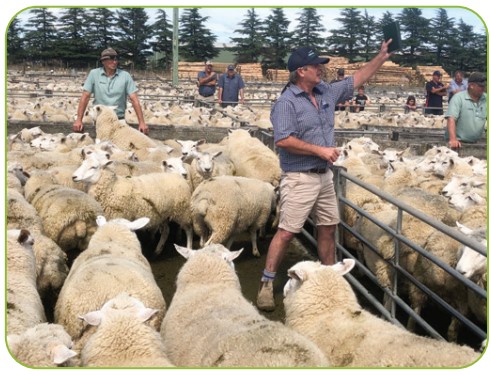
Going, going, gone …to pine trees. Capital stock Wairere Tufguy two tooths from Birch Hill Station sold at Masterton, January 2022.
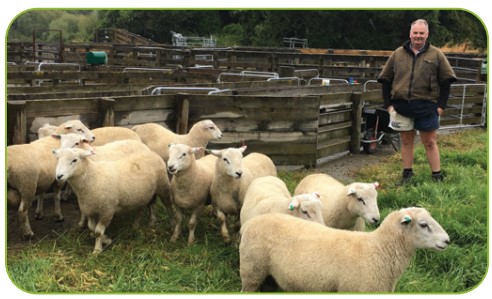
Dion Kilmister with Tufguy ram lambs, February 2021. Dion and Ali’s delicatessen in Masterton is a class act, and also sends “Homegrown” lamb and beef packs around NZ. “Homegrown” features Charolais/Tufguy ewe lamb cuts that have white intramuscular fat. This lamb won the Supreme Award at the Outstanding NZ Food Producer Farm Awards in 2021.
Wairere wins Wairarapa Farm Business of the Year
Wairere is privileged to join a group of outstanding farmers. Winning is a great way to highlight the contribution of key people over the years. In particular, Simon Buckley (35 years and counting), Pierre Syben (ten years from 2003, currently farming and selling rams at Wairere Australia), Andrew Puddy (15 years), Lynette Towler (15 years), and shorter stints from the younger generation like Jacques Reinhardt, Anna Vaughan and Sam O’Fee. Sheep and beef farmers should take a bow for their continual improvement in productivity. Over the past seventy years the transformation of local landscape from scrub to pasture in the northern Wairarapa has been huge. Instead of small herds of thirty dairy cows on swampy flats putting out cream cans at the gate, with Manuka spreading across the hills, there is now clean hill country and drained flats.
The field day is scheduled for November 17th.
Climate change
The world has been through sixty years of bingeing on fossil fuels. Our whole way of life is underpinned by cheap energy. On the Nuffield tour of the UK in 2017, we visited a 10,000 hectare estate in Scotland owned by the second generation of a Qatari family. Though the estate ran Wagyu beef cattle, the big earner was bottling water and air freighting it to Abu Dhabi, a few thousand tonnes of GHGs away.
Last September Wairere used a “methane trailer” to measure the emissions from 300 ram hoggets. Believe it or not, there was a strong correlation between the size of the sheep and methane emissions. Should we breed smaller sheep?
As for New Zealand’s version of greenwashing, planting pine trees to offset GHG emissions, the EU’s chief trade negotiator, Caroline Lambert, visited a farm in the Wairarapa in May and told farmers there that she had a dim view of New Zealand’s planting policy. Australia, which hasn’t signed the Paris Accord, has been ripping out eucalypt plantations and replacing with pasture. These plantations were planted because of huge tax breaks and the promise of a lucrative market. The market didn’t live up to the promise, so two forestry companies went broke ten years ago, the assets bought for a bargain price by foreign funds. It is estimated that taxpayers lost $A20 billion. Sound familiar?
Our competitors in Australia
Sheep numbers jumped 10.6 million between 2019 and 2021. Australian farmers are moving away from Merinos for wool to sheep for meat. Steady increases in per head productivity are being achieved with the adoption of New Zealand genetics, Dorpers, crossbred maternals and terminals, and improved Merinos.
The average export lamb carcase will be around 25kg this season, and forecast export tonnage at 283,000t is getting closer to New Zealand’s shrinking annual total. The largest supplier of self replacing maternal rams, Tom Bull, sold 1,400 ram lamb sires last November, born June/July, at an average of $A4,000 each.
Rapid changes
Five year interest rates have doubled, from 3.5 to 7% since November 2021. Hill country land prices have soared, mostly out of the reach of sheep farmers. Even some dairy farms are being planted. James Shaw talks about “stranded assets”. Who will want pine logs in 2050, with China self sufficient by 2035?
On the positive side, the demand for quality protein underpins the world market for sheep meat and beef. There is recognition that the nutritional value of meat from animals grazed on pasture is higher than the meat from animals fed indoors for their entire lives. A surgeon spoke at the Australian Red Meat conference two years ago, saying that he despaired of having to do amputations on Australians who had vegetarian diets with too much sugar. Columnist Joe Bennett, wrote a very perceptive editorial in The Press in June, about the assumptions of some people that the Earth is in danger of destruction, and the best way to prevent that from happening is to stop farming animals and stop eating meat.
Success stories
John Stirling, Northland.
John, with the help of his father Robert, runs 750ha effective Paoneone farm on the Purerua peninsula north of KeriKeri harbour. John achieves impressive results from mating the 4, 5, and 6 year Wairere Challenger ewes on January 20th, and the younger ewes on February 15th. In 2021 the 2,100 ewes weaned 156%. Weaned around October 20th, there were 700 POM at 16.5kg, 1,500 sold store at 29kg at $130, and over 1,100 ewe lambs and small wethers retained.
Most of the sale lambs are sold at the peak of the market, and the ewes have three months to recover before the next mating. John: “We grow our best grass in the autumn and early winter. Springs are a non event, with cold southwest winds drying out pasture. The secret is keeping good BCS on the ewes. I don’t mate hoggets, and the two tooths sometimes scan better than the mixed age ewes. The size and fertility of these Waireres is ideal. I take the same approach with our 350 cows and pregnant R2 heifers. The vet was astounded that there were only two drys this year! The bulls come from Matauri Angus, where the cows are run commercially on average Northland hill country, just as Wairere does with sheep. Steers are sold as yearlings, heifers put to the bull with the surplus sold in calf in May. It’s a 40% sheep 60% cattle ratio, but the sheep make more money than the cattle. Annual fertiliser is 250kg of Super with selenium on the flat to rolling country, plus 500-1,000kg of lime.
Every year we spray out around 50ha of kikuyu pasture, then direct drill Italian ryegrass and three types of white clover. It lasts two years, then the kikuyu grows through it. Chicory goes well here, but thousands of Paradise ducks want to eat it before the sheep.” John’s father Robert leased several properties on the KeriKeri peninsula in the 1990s, running 26,000su and 10,000 ewes, and buying some Wairere East Friesian/Romney rams. Then the GFC disrupted farm ownership and the leases, but he was able to buy his own farm inland.
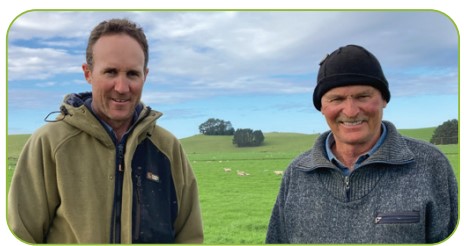
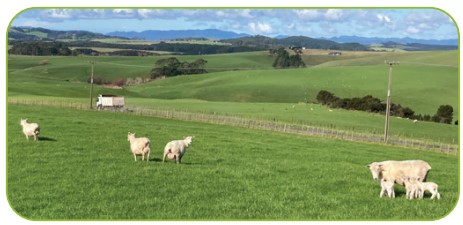
Sam and Jaime Benoit, Pahiatua.
Eleven years ago Sam and Jaime Benoit took over the lease on a 330ha farm east of Pahiatua. With an average altitude of 500m above sea level, topping out at 700m, the property is exposed to the northwest and has an average rainfall of 1,700mm. Prior to farming, Sam was working as a farm consultant with Greg Shepherd. Jaime, Andrew and Margaret Puddy’s daughter, was a valuer with QV Ltd. She has continued as an independent valuer, though has wound down with two children now.
Sam: “ We took over a high performing Coopworth flock which had been detuned with a Texel cross by the previous lessee. Putting Wairere rams over those sheep has evolved a consistently high performing flock. Lambing has been 148-150% over the past five years. I target 3,100 lambs from the 1800 ewes and 600 hoggets, done that once, and usually do 3,000 plus. I mate around 20% of the ewes to a terminal, because I like to have plenty of potential Romney ewe lamb replacements to choose from. I’ve achieved 40% POM, but 25% is the norm. Cattle numbers are 85 in calf cows and heifers, 40 weaners, and 40R2 cattle.
We had an uncomfortable feeling five years ago, because we had no debt remaining! That decided us to invest in a small block of land, sold on 18 months ago to lock in capital gain. Back to no debt! so invested in a residential property in late 2021. We are hoping for a reset in farm land prices that will allow us to re-enter farm ownership at prices more in line with historical farming values. But will this carbon subsidy extravaganza ever stop?”
Congrats to Sam and Jaime, one of the “young gun” couples who will achieve farm ownership after starting with nothing.
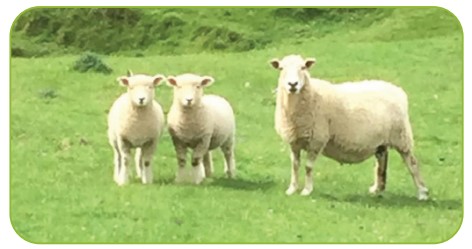
Above: One of Sam Benoit’s Wairere bred ewes, twins 50 – 60 days old.
Top left: John and Robert Stirling, Northland.
Bottom left: John Stirling’s triplet ewes on autumn grown grass mid July. Who said Wairere Romney ewes can’t be lambed early at 150% plus?
Nick and Penny France, Mid Canterbury.
We farm 950ha at 500 meters above sea level with a mix of rolling, easy and steeper hill in the Mount Somers District. With a ratio of 55% sheep and 45% cattle, including the Okawa Hereford stud. “We did an on farm trial about twelve years ago, comparing the progeny of two Wairere rams to the progeny of our long time ram breeder. The Wairere first cross lambs were 1.7kg heavier at weaning And the Wairere progeny as two tooth ewes had a better scanning index, with lambs 2kg heavier at weaning. They bounced back better, holding higher body condition score and live weight during probably our driest period farming the property. Chris Mulvaney of Stockcare organised the trial. Its fair to say we proved Wairere’s marketing statements correct, and when you include Wairere mating hoggets and being part of the Stockcare group it was a no brainer to move to their rams.”
We use hybrid vigour to our advantage, being the only free lunch in farming. We have two ewe flocks, with a third of the Romney ewes going to East Friesian/Texel rams. The females of that cross, first cross TefRom ewes, go to terminal sires, with two thirds of the lambs going POM at 18kg before Christmas. The ewes consistently lamb 150% and sometimes high 150s. The Tefrom hoggets are mated as hoggets also, and consistently lamb at 100 to 130% with a third going to the works off mum.
Sixty percent of our income is derived from sheep. Farming at 500 meters above sea level and 9su/ha means our Bull Stud philosophy is totally focused on providing quality feed for “all grass wintering” ewes, ewe lactation, hogget mating and finishing all of our lambs to an average of 19kg. All of our cows are registered stud cows and are expected to clean up and set up pasture for our high performance ewe flocks. We keep the pressure on the cows and expect them to raise a commercially realistic sized calf and get back in calf year after year. They’re basically a tool for ensuring sheep performance in a commercially realistic environment. Not too many Bull studs in the country have that as a focus!
Okawa Hereford bull sale averaged just under $10,000 this year, including NZ’s highest price stud bull at $47,000 and one at $35,000. We haven’t had to provide a credit bull in the last three years which means there’s no “Funny Money” pushing the average up at the sale. The Herefords’ structure and ability to perform in a true commercial environment is what its all about. We are finding a number of Angus herds are now using our bulls for hybrid vigour and creating the optimal black cow with white face in their herd. A very similar concept to the hybrid vigour we create in our first cross Tefrom ewes.
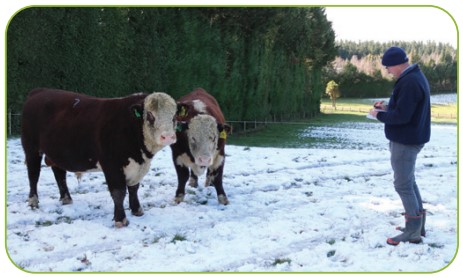
Byron and David Vollweiler, South Otago.
“The farm is 1,100ha with 200ha in pine trees, 15 minutes north of Millton. When I came home the flock was Highlander, but Wairere Romney rams have been used since 2012. Lambing percentage has dropped a little, from 160s to 155 average, but I reckon that above 50% the financial returns even out. The Waireres cope better in a hard season, giving us consistent performance year in, year out.
Regulations have challenged us to change from swedes as a winter crop to a brassica/ryegrass mix. But the change has been positive for stock performance because of improved late pregnancy feeding. We start lambing September 7, and wean December 7. That gives room to spray out and direct drill our winter crop in mid December, allowing us to utilize the whole farm as a lambing platform.
We used to farm a lot of cattle, but their wintering area has been planted in pine trees. There are four sawmills within fifteen minutes, and the Dunedin port is only an hour away…right tree, right place. Finishing Cattle used to be wintered on fodder beet, but it was hard on the ground, and needed a lot of chemical inputs.”
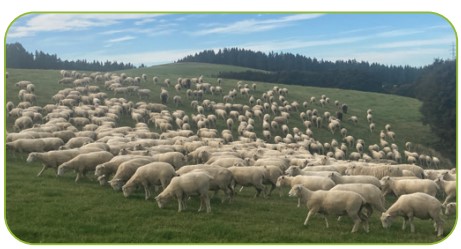
Above: Byron’s ewe hoggets with black teaser rams, May 6th. Mated those at 46kg and above. Byron has also been awarded Supreme Winner of the Otago Ballance Farm Environment Awards 2022
Left: Nick France inspecting his bulls.
Ram pricing
The costs of ram breeding have increased faster than the costs of commercial farming. Farmers paying $10,000 for a bull with residual value of $2,000 would pay $7,000 for a ram relative to value of progeny influenced. A bull at $4,500 is equivalent to a ram at $2,100. The latest AgLetter’s analysis of the top 25% of farmers shows sheep returns at $170 per su, cattle returns at $85 per su.
Last year Wairere’s bottom two price brackets were only five percent of sale numbers. Demand was evenly split between the top two price brackets, $1,650 and $1,200. The new price brackets will be:
$1,950, $1,450, $1,100. There will also be an elite bracket at $2,750 which will be restricted to two hundred rams after Wairere keepers and stud ram sales.
A feature of Wairere is large scale, over 20,000 ewes and lambing hoggets dedicated to improving your flock. That gives us huge culling pressure and gives you high quality at any price bracket.
Here’s wishing you a bumper lambing and a kind spring.
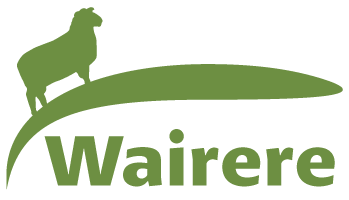
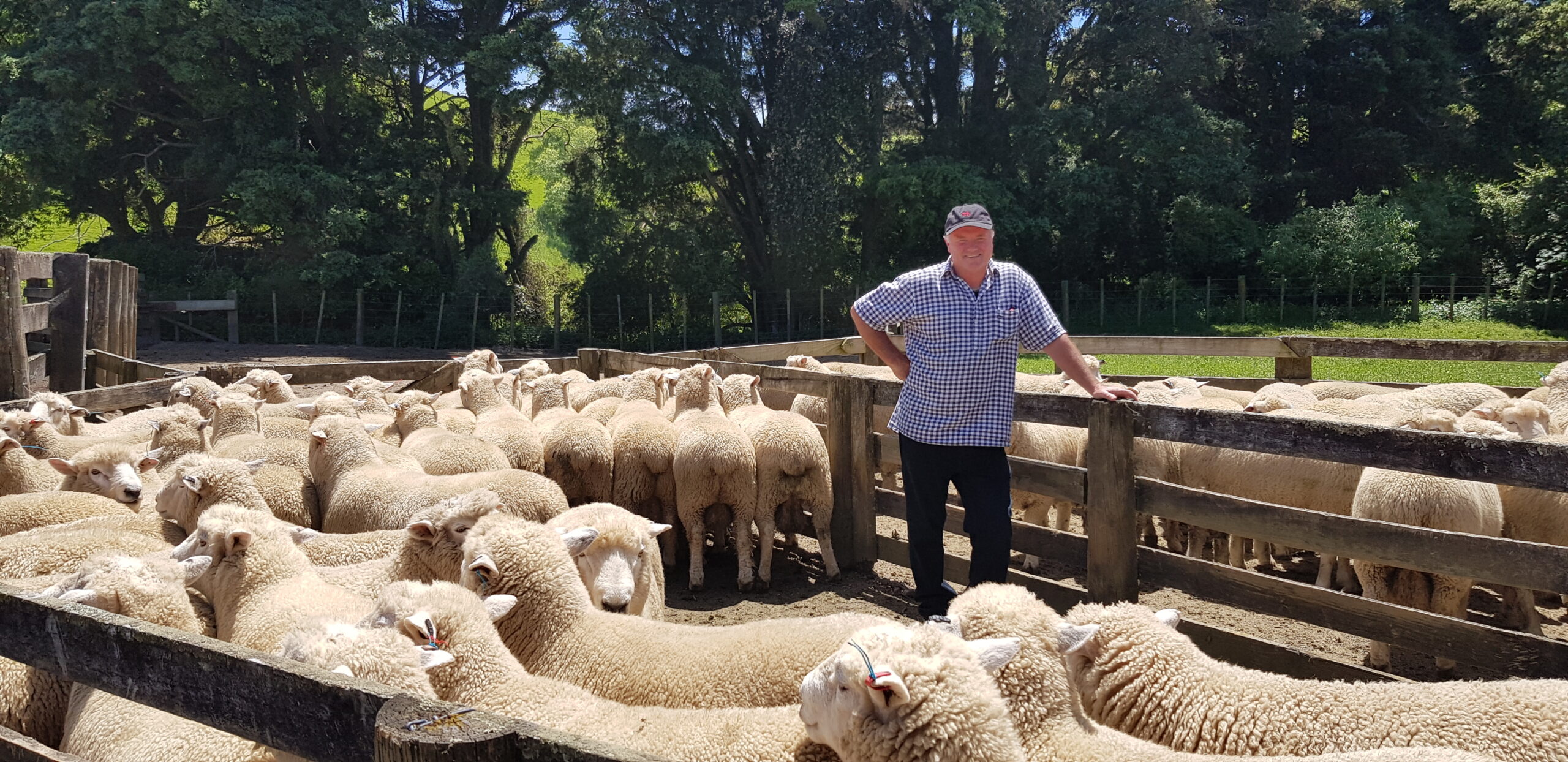
Recent Comments